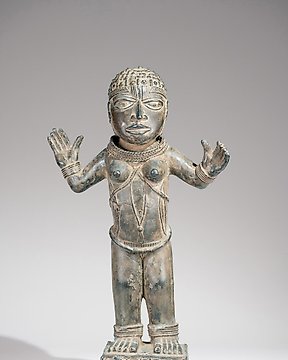
Benín - Nigeria
N.º 83341603

N.º 83341603

A bronze plaque in the style of Benin, wide, rectangular plaque with side flanges background surface decorated with river leaf patterns and polka dots, two nail holes at the bottom. Shows standing Oba facing forward, flanked by two high ranking companions, who also face forward, one supports his left arm, the other holds an unidentfied object in his hand, the Oba wears a helmet-like beaded crown with spike-like appendages, a beaded collar partially covering the mouth, a sash over the chest and stomach, arm and ankles with beaded anklets, and a patterned wrap-around skirt with a passport mask on the right side of the belt. The high-ranking companions dressed similarly: layered hairstyle, pearl necklaces, armbands and a wrap skirt tied over the right hip; The upper and lower rims are fragmentary, some bridges due to corrosion, but in general of relatively good condition in relation of other Benin plaques.
Oba with high-ranking companions, former "Königliche (last photo sequence) Museum für Völkerkunde in Berlin, 1898"."
Following the British occupation of Benin City (Edo) in 1897 objects made of brass, ivory and wood were looted by British forces from the royal palace, its storerooms and compounds. Some of these objects were sold or exchanged on the coast. However, many were brought to the UK where they were sold through private auction, donated to museums, or retained by soldiers of the expedition. The British Museum successfully petitioned the government to secure some of the relief plaques and over 300 were sent to the UK by the Consul-General [Sir] Ralph Moor and placed at the Foreign Office. During the summer of 1897 the Crown Agents for the Colonies, on behalf of the Foreign Office, agreed a temporary loan of 304 plaques to the British Museum. In September these were placed on public display in the Assyrian basement where they attracted considerable public attention. The Museum initially received 203 of these plaques as a gift from the Secretary of State for Foreign Affairs. In the summer of 1898 a further eleven plaques were sent to the British Museum from the Foreign Office and three of these were selected by the Museum and were subsequently presented as a gift. Of the remaining plaques the Foreign Office retained eight and the rest were offered for sale to major museums, collectors and private dealers in Europe and the UK. Today over nine hundred plaques are known to exist in museums and private collections around the world. See Collection File: Af1898,0115.1-203 (previously Eth.Doc.185)."
Source: Digital Benin.
TL-Analysis 260 years +/-29,7 %
Cómo comprar en Catawiki
1. Descubre algo especial
2. Haz la puja más alta
3. Paga de manera segura